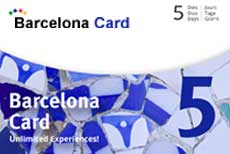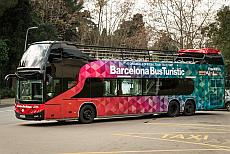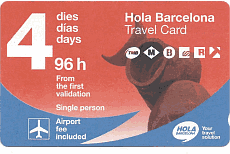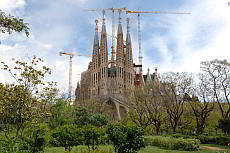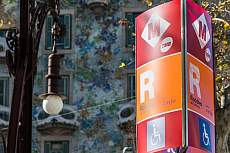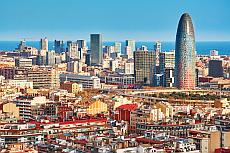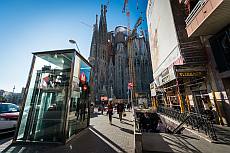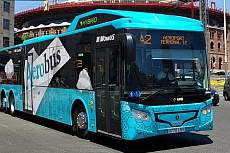How to use public transport in Barcelona
Overview of public transportation, tips for use and tickets
Barcelona is huge, but with the modern and very well-developed local public transport you can quickly get to any place within the city.
Content of this Page
The network of metro, bus, tram, and trains in Barcelona is very well-developed. You can reach almost anywhere with the metro and tram. There are more than 230 bus lines and an additional 30 night bus lines available, complemented by funiculars and cable cars.
At first glance, it may seem difficult to navigate the transportation system in Barcelona. However, it is very easy to find your way around the network of various transportation modes and move quickly and comfortably.
Fare zones
The entire city of Barcelona and the airport are located in Zone 1. Most of the city's attractions can be reached within this zone, so a ticket for Zone 1 should be sufficient in most cases.
Fare zones on the map
Here you can download the line map with the fare zones (PDF):
Zones 2-6 cover the outskirts and more distant areas. For example, the seaside town of Sitges is in Zone 3, the popular destination of Montserrat Monastery is in Zone 4, and Malgrat de Mar is in Zone 6. Information on how to reach these places can be found on their respective pages or on our page "Getting to Destinations Outside of Barcelona."
Tickets for public transportation
Here, we describe the tickets that are of interest to our guests, whether tourists, trade fair visitors, or business travelers.
We exclude other tickets that are more geared toward locals, such as monthly or yearly passes.
The various tickets and ticket prices for 2024
- Hola BCN! ticket for 48, 72, 96, or 120 hours (€17.50, €25.50, €33.30, or €40.80)
- Free and unlimited use of public transportation throughout the entire city of Barcelona (Zone 1)
- Includes airport transfer (except Aerobús, which is privately operated)
- Super comfortable and flexible: simply hop on the metro & more and go
- A "must-have" for your Barcelona stay
- It's the most widely used ticket for Zone 1
- More information about the Hola BCN! multi-day tickets
Who is the ticket suitable for?
- Always when you don't want to bother with tickets. It's very easy to use.
- It's worth it after just a few rides compared to other tickets
- The validity starts only from the first use
- Super flexible
Disadvantages:
- You cannot interrupt the validity period
- The Barcelona Card also offers free use of public transport: the Hola BCN! ticket for 72, 96 or 120 hours is included
- In addition, the Barcelona Card is worth it multiple times: free and discounted admission to many attractions, free admission sometimes without queuing at the line
- Audio guide app for your smartphone
- This ticket package is ideal if you want to comfortably travel from the airport to the city and using public transportation
- Hola BCN! ticket for 48, 72, 96, or 120 hours
- Aerobús for convenient transfer from Barcelona Airport
- Audioguide app for your smartphone
- The Aerobús is a comfortable shuttle bus that connects Barcelona El Prat de Llobregat Airport with the city center of Barcelona
- You can quickly reach the city center or vice versa to the airport
- Comfortable with extra storage space, suitable even for large suitcases
- Luggage is included in the price
- For more information, visit: Aerobús - the comfortable airport transfer
T-dia - Ticket for one calendar day
Unlimited rides on one calendar day.
Ticket price: €11.20
When it's worth it:
- If you're only staying in Barcelona for one calendar day, for example, because you have a layover at the airport or if you have some time after a cruise
Disadvantages:
- Valid for only one calendar day, if you stay overnight and want to travel again the next morning, you'll need additional tickets
- Airport ticket not included
Single tickets
With the single journey, you can travel for 1 x 75 minutes on all TMB transport, but only in one direction.
Single fare: €2.55
When it's worth it:
- If you're sure you'll only make a few trips on public transport during your stay
Disadvantages:
- Comparatively expensive
- Airport not included
- Valid for exactly one journey, if you change direction, you'll need to purchase a new ticket
- The driver on buses only sells single tickets, which do not allow transfers to the metro
- Time-consuming to buy a ticket every time
- Rarely worth it, as most guests use the metro more frequently
Airport ticket
If you don't have a Hola BCN! ticket, you'll need this ticket for the metro to Barcelona Airport. Single fare: €5.50 per direction
When it's worth it:
- For a single transfer, for example, if you need to get from the cruise port to the airport and want to save on taxi fare
Disadvantages:
- Quite expensive, especially when combined with other tickets, such as single tickets
T-casual (10-journey ticket)
With this ticket, formerly known as "T-10," you have 10 journeys free.
Ticket price: €12.15
When it's worth it:
- If you only plan to make a few journeys during a longer stay
Disadvantages:
- You need an account with TMB (T-Mobilitat), it cannot be used anonymously
- Unused tickets expire
- If 10 journeys are not enough, you'll need to purchase additional tickets
T-dia, single tickets, airport ticket, and T-casual are available at ticket machines and through the TMB app.
Children up to three years travel for free; they do not need a ticket.
Unified prices apply without discounts, such as for seniors or apprentices.
Metro and tram: the main modes of public transportation
We consider the subways and trams in Barcelona to be the most important means of transportation for visitors. The metro network in Barcelona is very dense, largely barrier-free, and absolutely reliable. The lines run at frequent intervals of up to 1-2 minutes. So, you don't need timetables. Only for metro line L9 to the airport, you need an extra ticket, which is however included in the Barcelona Card or Hola BCN! ticket.
The tram network is also being expanded. It complements the subway network with several lines, and at many stops, you can transfer between subway and tram.
Information on Metro Line "L9 Sud" to the Airport
Metro Line L9 Sud connects the two airport terminals T1 and T2 with the rest of the city's metro network via the "Zona Universitària" station. From there, you can transfer to Line L3 to reach the city center.
Lines L9 and L10 each have two branches. To distinguish them, "Sud" (south) or "Nord" (north) is added. The "L9 Sud" line goes to the airport.
How to use metro & tram
You will quickly find your way around the metro. If you want to reach a specific destination, such as Golondrinas in Port Vell, locate the nearest metro station on the map and see which line goes there. In this example, it's the "Drassanes" station on Line L3.
Hints for disabled people
Significant investments have been made in the accessibility of public transportation. For example, nearly all metro stations and buses are accessible to wheelchair users.
Board the metro at the next station. Check the timetable, which you either have with you (e.g., with the Barcelona Card) or is displayed in every metro station, to see which direction you need to go. Remember the name of the terminal station in the direction you need to travel.
For example, Line L3 has the directions "Trinitad Nova" and "Zona Universitaria". Signposts with this terminal station are displayed in the metro stations, which you simply need to follow until you reach the platform. The platforms themselves are colored according to the line, for example, green for Line L3.
If you need to change lines, remember the interchange station and follow the signposts as described above to the next line. Also, note that sometimes you may have to walk long distances in the interchange stations.
Metro and tram map
You can download a complete metro map here (PDF, 1.2 MB). Complete network maps are displayed at every metro station, and you can also get them for free at the ticket counters and tourist information offices.
A metro map is also included in the Barcelona Card and the Hola BCN! ticket.
Entry into the metro station
You can only enter the metro station with a valid ticket (tram stations can be entered without a ticket, but you must validate your ticket on the tram).
You can purchase tickets from machines before entering. However, it's easier with multi-day tickets, which allow you to simply enter: insert the ticket into the validator, and the gate will open once you have removed the ticket from the top of the validation machine. Do not enter from the wrong side of the machine; a green arrow indicates which gate will open for you.
Operating hours of the metro and tram
- Mondays to Thursdays: 05:00 - 24:00
- Fridays and evenings before a holiday: 05:00 - 02:00
- Continuous operation from Saturday to Sunday
- Sundays and holidays: 05:00 - 24:00
- 24 December: 05:00 - 23:00
- Continuous operation also on nights before 1 January, 24 June, 15 August, and 24 September
- Line L9 Sud (to the airport) operates daily from 5:00 to 24:00
- Outside metro hours, there are night buses (see below)
Aerobús - the comfortable airport transfer
The Aerobús is a rather comfortable shuttle to the airport. There's plenty of space in the bus, and there are racks for larger suitcases.
It departs from both terminals to the city center, specifically to the centrally located Plaça Catalunya. Since it only stops at a few stations, the transfer is much shorter compared to other modes of transportation. The Aerobús is also ideal if you're arriving or departing very early or late, as it operates 24/7, 365 days a year. You can book tickets in advance. For more information and tickets, visit our "Aerobús - the comfortable airport transfer" page.
The journey takes approximately 35 minutes each way.
Buses and night bus lines (NitBus)
Bus schedules and route maps
Timetables of individual bus lines and overview map of NitBus:
- Buses of the TMB: Individual bus lines within Barcelona
- NitBus: Bus route map and stops at Plaça Catalunya
In Barcelona, over 230 bus lines are operated by the municipal transport company TMB, in addition to 20 night bus lines. A printed network map, like the one for the metro, is quite confusing and, due to its size alone, not practical. Therefore, it's difficult to determine which bus will take you from point A to point B. If your hotel is located a bit further away from a metro station, the reception will definitely tell you which bus to take. Your hotel may also provide maps of individual bus lines. Bus schedules are also available at tourist information centers.
Operating hours of the buses
The operating hours of the TMB buses vary for each route and also differ on different weekdays and holidays. It may be a regular interval schedule or a schedule with specific departure times. You can find a timetable posted at each bus stop.
Generally, buses run from around 5:00 to around 22:00.
Night buses (NitBus)
Neither the metro nor the regular bus lines operate throughout the night. However, Barcelona has a fairly extensive network of night buses that can take you back to your hotel all night long. Except for line N0, all lines stop at Plaça Catalunya, where you can transfer to other NitBus lines. Line N0 is a circular route that allows you to travel around the city center and connect to other NitBus routes. The night buses are operated by the private company AMB, so the Barcelona Card and Hola BCN! Ticket are not valid on these buses.
Line N17 runs to the airport, and other lines serve destinations around Barcelona.
The operating hours of the NitBus lines also vary for each route, but they generally run from around 22:00 to 05:00.
Taxi rides in Barcelona
Taxis are a quick alternative to buses or the metro, especially at night when the metro is not operating. There are countless taxis available, and the fares are relatively inexpensive compared to Central European standards.
Taxi dispatch centers
Several taxi dispatch centers accept your telephone booking:
Taxis in Barcelona are black and yellow, and you can identify available taxis by the green light on the roof. Overall, there are 5,772 taxis in Barcelona (as of January 31, 2024).
How to hail a taxi in Barcelona
Most taxis do not wait at taxi stands but rather roam the streets in search of passengers. You can simply wave one down, as taxi drivers are adept at spotting potential fares. However, within 50 meters of a taxi stand, a driver is not allowed to pick up passengers.
At the over 260 taxi stands in Barcelona, you theoretically have the option to choose any vehicle. However, drivers will typically direct you to the first taxi in line, and you must take that one. Under special circumstances, such as needing a larger taxi or preferring to pay by credit card, you may choose another taxi.
If you need a taxi at a specific time and location, such as your hotel, you can call one of the taxi dispatch centers to request a taxi.
Alternatively, you can easily hail a taxi using a mobile app. "App AMB Mobilitat (Picmi)" is the official taxi app of the AMB. Additionally, there are many other taxi apps available, such as Baixtaxi, FREE NOW, Radio Taxi 033, or Uber.
Taxi fares 2024
Download fares
You can see the current fare displayed on the roof of the taxis: T1 - T4. The taxi fares are also displayed on the taxis, usually on the rear side windows.
- T-1: Weekdays between 08:00 and 20:00
Initial fee: €2.60
from the airport: additional €4.50
from the fairgrounds: additional €2.50
from Sants train station: €2.50
for 5-8 passengers: €4.50
Rate per kilometer: €1.27
Waiting time: €25.60 per hour - T-2: Weekdays, Saturdays, and holidays from 20:00 to 08:00
Initial fee: €2.60, additional initial fees as above
Rate per kilometer: €1.56 - T-4: Route between the airport and the Moll Adossat cruise terminal: €45 including surcharges
From the airport to the city center, the minimum fee is €21.00. Additional fees are charged for certain destinations:
- Airport: €4.50 (one way)
- Ferry/cruise ships: €4.30 (one way)
- Sants main train station: €2.50 (one way)
- Fairgrounds (Fira): €2.50 (one way)
- Special night fares from 20:00 to 8:00 on the following nights: 23/24 June, 24/25 December, 31 December/1 January: €4.50
- For larger taxis (5-7 passengers): €4.50
- Wheelchairs and guide dogs ride for free
A taxi from the airport to the city center costs around €40, depending on your destination and traffic conditions. Additional charges apply for airport transfers, luggage, and possibly nighttime travel. When starting your journey, ensure that the meter is activated and request a receipt. Some taxis offer credit card payment, which is indicated on the window pane.
City tours with the Hop-on Hop-off buses
In Barcelona, two operators offer city tours with double-decker sightseeing buses. The red buses by Greyline operate two lines, while the turquoise-red buses, Bus Turístic, belong to the municipal transport company TMB, running on three lines (two in winter).
Info Hop-on Hop-off busses
On our hop-on hop-off-bus tour page, we provide comprehensive information such as route maps, operating hours, and fares:
With both bus companies, you'll pass by most of the city's attractions. It's ideal for getting an overview and visiting a few sights. You can hop on and off at any time or switch routes.
The pure travel time per route is about 2 - 2.5 hours, for the green East route of the Bus Turístic approximately 70 minutes.
To Tibidabo with the Tramvia Blau and Funicular
The Tramvia Blau, the Blue Tram, to Tibidabo is world-famous. The historic tram passes by magnificent Art Nouveau villas on its way to the lower station of the Funicular. Once you reach the top, the Funicular takes you to the Tibidabo amusement park, the Sagrada Corazón church, and a 5-minute walk to the Torre de Conserolla.
It would be wonderful if you could ride the Tramvia Blau; it's a true and charming gem. Unfortunately, the Tramvia Blau has been out of service since early 2018 due to restoration works. No one knows when the tram will resume its service. However, you can still take the bus to the Funicular.
Cable Cars to Montjuïc
Telefèric de Montjuïc
You can glide up to Montjuïc on two cable cars. With the Telefèric de Montjuïc, you can ride directly to the Castell at the top of the mountain. You can reach the lower station of the Telefèric either by the Bus Turístic or by the funicular.
Telefèric de Montjuïc
To access the Funicular, you can transfer at the Paral·lel metro station on Line 3. At the end of the Funicular, you can either walk about 200 meters to visit the Fundació Joan Miró Museum or board the cable car and enjoy a wonderful view of the city, the sea, and the port from above. The cable car ride itself is an experience.
Aeri - Cable Car from the Port to Montjuïc
The Transbordador Aeri del Port cable car connects the Barceloneta neighborhood across the port to Montjuïc. To reach the tower on the port side, you can either walk or take bus line 64 (towards Barceloneta) from Drassanes station. The approximately 10-minute, 1,300-meter cable car ride offers a beautiful view of the Old Port and the old town.
Trains of the FGC and Renfe
Train network of the FGC
Here you will find the metro and Renfe network.
The FGC (Ferrocarrils de la Generalitat de Catalunya) is the Catalan railway company that operates suburban trains. Renfe is the Spanish railway company that operates long-distance trains. The trains run along the Costa Brava to Blanes, 50 km away, to the airport, along the coast through Castelldefels and Sitges to Tarragona. To the northwest, the trains pass places like the Montserrat Monastery.
The lines converge in Barcelona, where they run underground like the metro and are integrated into the public transportation network. You can navigate them just like the metro, and there are underground connections between metro, Renfe, and FGC stations. Tickets are also valid here.
You can take the Renfe from the airport (for more information: "Transfer with Public Transport - Airport Barcelona"). They run from Plaça Catalunya to Tibidabo and to the neighborhoods of Gràcia and Sant Gervasi. For places further away, see "Travel to the Cities of Catalonia".
Purchase public transportation tickets here
(Click on the product images to view prices and availability)
Book your accommodation in Barcelona here! All categories.
1-5*-hotel rooms, apartments, hostels.

